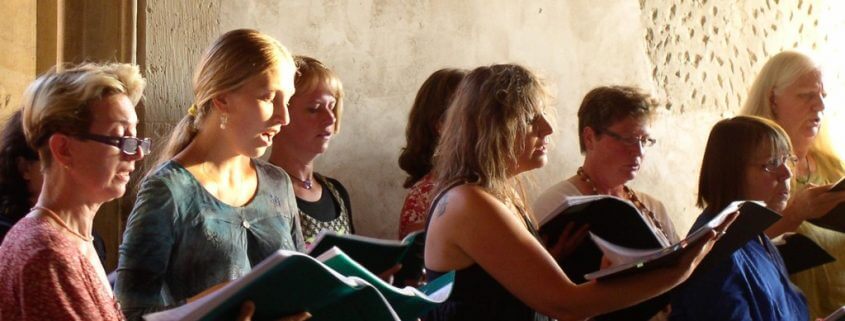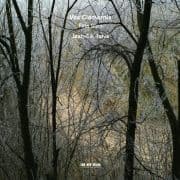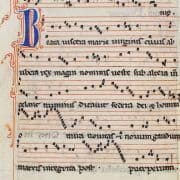Exploring Vowel Overtone Singing in “Singing in Tune with Nature”
Das neue Chorwerk “Singing in Tune with Nature” der australischen Komponistin Amanda Cole demonstriert wieder einmal, wie vielfältig die kreativen Möglichkeiten des vokalen Obertongesangs in der Chormusik sind. Dieses innovative SATB-Chorwerk war Finalist bei den APRA AMCOS Art Music Awards 2021 in der Kategorie Chor.
“Singing in Tune with Nature” wurde für das N.E.O. Voice Festival 2020 komponiert, das abenteuerliche Vokalmusik zelebriert. Das Festival wurde gegründet, um das weitreichende Potenzial der menschlichen Stimme zu erforschen und neue Werke vorzustellen, die von der neuesten Vokalforschung inspiriert sind.
In diesem Stück verwendet Cole die mikrotonale Reinintonation anstelle der zwölftönigen gleichschwebenden Stimmung des Klaviers. Dadruch wird ermöglicht, dass jedes gesungene Intervall direkt aus der natürlichen harmonischen Obertonreihe abgeleitet wird, die in jeder Stimme vorhanden ist. Der Effekt erzeugt schimmernde Wolken schimmernder Obertöne, ähnlich wie beim Obertongesang, nur zarter, versteckter, und – wie der Hörtest von Wolfgang Saus erfahrbar macht – für jeden Menschen ein wenig anders.
Laut Programmheft ist dieser Ansatz als Metapher für die Wertschätzung und Konzentration auf die Wunder der natürlichen Welt gedacht. Die mikrotonale Stimmung erfordert ein tiefes Zuhören zwischen den Sängern, die zu einem einheitlichen Chor verschmelzen.
Australian composer Amanda Cole’s recent choral work “Singing in Tune with Nature” showcases the creative possibilities of vocal overtone singing. This innovative SATB choir piece is a finalist in the 2021 APRA AMCOS Art Music Awards in the choral category.
“Singing in Tune with Nature” was composed for the 2020 N.E.O. Voice Festival, which celebrates adventurous vocal music. The festival was founded to explore the expansive potential of the human voice and feature new works inspired by cutting-edge vocal research.
In this piece, Cole utilizes microtonal just intonation tuning, rather than the twelve-tone equal temperament of the piano. This allows each sung interval to come directly from the natural harmonic overtone series present in every voice. The effect creates shimmering clouds of lush overtones, similar to overtone singing, only more delicate, more hidden, and – as Wolfgang Saus’ hearing test makes it possible to experience – a little different for each person.
According to the program notes, this approach is meant as a metaphor for appreciating and focusing on the wonders of the natural world. The microtonal tuning requires deep listening between singers, blending as a unified choir.
Beyond her choral writing, Amanda Cole is known for composing experimental electronic and instrumental music. She writes software for interactive performances, often collaborating with other artists. Cole holds a PhD in composition from the Sydney Conservatorium of Music, where she currently teaches.
Her nomination for this APRA AMCOS Award recognizes Cole’s adventurous musical voice. “Singing in Tune with Nature” expands our conception of choral possibility, embracing the voice’s hidden overtone colors. Exploring new tuning systems and extended techniques, Cole’s music connects to universal elements of nature and the human spirit.
Neben ihrer Chorarbeit ist Amanda Cole auch als Komponistin experimenteller elektronischer und instrumentaler Musik bekannt. Sie schreibt Software für interaktive Aufführungen und arbeitet dabei oft mit anderen Künstlern zusammen. Cole hat einen Doktortitel in Komposition vom Sydney Conservatorium of Music, wo sie derzeit unterrichtet.
Ihre Nominierung für den APRA AMCOS Award ist eine Anerkennung für Coles abenteuerlustige musikalische Sprache. “Singing in Tune with Nature” (Singen im Einklang mit der Natur) erweitert unsere Vorstellung von chorischen Möglichkeiten, indem es die verborgenen Obertonfarben der Stimme berücksichtigt. Indem sie neue Stimmsysteme und erweiterte Techniken erforscht, verbindet sich Coles Musik mit universellen Elementen der Natur und des menschlichen Geistes.





Recent Comment